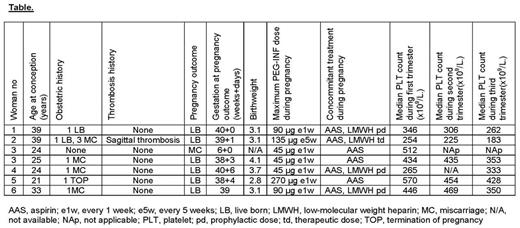Abstract
Essential thrombocythaemia (ET) is a rare (only 20% are diagnosed at child-bearing age), acquired clonal stem cell disorder. Pregnancy in patients with ET is associated with an increase in foetal (spontaneous abortion, stillbirth, intrauterine growth retardation) and maternal complications (thrombosis, hemorrhage, preeclampsia). Although Interferon alfa-2a (INF) therapy in ET patients has been associated with improved pregnancy outcomes, data regarding pegylated-interferon alfa-2a (PEG-INF) in pregnant ET patients is not available and its use is currently not recommended. PEG-INF has an increased half-life in comparison with INF, requiring less frequent injections, is associated with a better tolerance profile and is increasingly used outside of pregnancy. For those reasons, it is an interesting alternative for pregnant ET patients.
This observational study is the first one focussing on use of PEG-INF during pregnancy. We included 7 pregnancies in 6 women with a diagnosis of ET treated with PEG-INF. Patients were identified through physician willingness to participate. In all pregnancies, PEG-INF was started before conception to control the platelet count. A specific questionnaire for data collection was sent to physicians. This study was performed in accordance with the Helsinki Declaration.
Median age and platelet count at ET diagnosis were 22 years (range: 12 - 34 years) and 1647 x109/L (791 - 3265 x109/L), respectively. Median age at the beginning of pregnancy was 25 years (21 - 39 years). 5 women (83 %) had a prior documented history of 8 pregnancies with 2 (25 %) live births, 5 (63 %) miscarriages and 1 (13%) termination. On the 5 previous miscarriages, all women were on low-dose aspirin (AAS), 2 on low molecular weight heparin (LMWH) and 1 on INF. The rationale to introduce cytoreductive treatment was high-risk ET in 5 (83%) woman (4 with platelet count >1500x109/L at diagnosis, 1 with previous sagittal sinus thrombosis) and complications in previous pregnancy in 1 (17%) women (numbness of right face and arm). In addition to PEG-INF, all woman received AAS and 4 (66 %) LMWH (3 (50 %) had prophylactic dose and 1 (17 %) had therapeutic dose for previous sagittal sinus thrombosis).
Median platelet count at conception was 520 x109/L (354 - 676 x109/L), 434 x109/L (254-570 x109/L) during the first trimester, 435 x109/L (225-469 x109/L) during the second trimester and 342 x109/L (183-428 x109/L) during the third trimester.
4 woman experienced PEG-INF grade 1 adverse events (AEs) (2 reported hair loss, 1 had transient nausea, anorexia and abdominal pain, 1 had skin reaction, 1 had headaches). Neither grades 3-4 AEs nor drug discontinuation was reported.
On the 7 pregnancies, 6 (86 %) live birth and 1 (14 %) miscarriage (at 7 weeks, platelet count of 492 x109/L) were reported. Median time of gestation at delivery was 39 weeks (range: 38+3-40+6 weeks) and median birthweight was 3.1 Kg (range: 2.8-4.1 kg). Delivery was vaginal for 7 (83%) and by caesarean for 1 (17%), with induction for 1 (17 %). Neither major bleeding nor thrombosis was reported during pregnancy, delivery or post-partum. There were no stillbirths nor infant malformations at birth. Patient's characteristics are summarised in the Table.
Outcomes of pregnancies for these 6 woman were significantly better when treated with PEG-INF during pregnancy with more live births (6 with PEG-INF, 2 without) (p<0.05).
In conclusion, PEG-INF improves outcomes of pregnancy in ET woman with significantly more live birth. Moreover it is efficient to control platelet count, with only few side effects and no infant complication reported. We report for the first time that PEG-INF seems a safe and interesting alternative treatment of ET in pregnancy.
Off Label Use: Peginterferon alfa-2a for cytoreduction in pregnant ET women. Harrison:Shire: Speakers Bureau; Sanofi: Honoraria, Speakers Bureau; Gilead: Honoraria; CTI Biopharma: Consultancy, Honoraria, Speakers Bureau; Novartis: Honoraria, Research Funding, Speakers Bureau.
Author notes
Asterisk with author names denotes non-ASH members.


